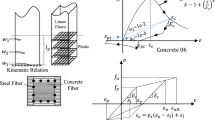Abstract
The double-edge notched specimen made of normal strength concrete has been subjected to compressive loads. It is shown that a shear crack develops at the notch tip. Visual observation and evaluation of displacement measurements have proven that this specimen allows pure mode II testing. It was possible to determine fracture toughness KIIc. Recommendations for the testing are made.
Résumé
Une éprouvette entaillée sur deux côtés opposés en béton de résistance normale a été soumise à des charges de compression. On démontre que la fissure de cisaillement se développe à la pointe de l’entaille. L’observation visuelle et l’évaluation des mesures de déplacement montre que ce type d’éprouvette permet des essais en mode II pur. Il a été possible de déterminer la résilience à la rupture KIIc. On donne des recommandations pour des essais.
Similar content being viewed by others

References
RILEM Technical Committee 50-FMC, ‘Determination of the Fracture Energy of Mortar and Concrete by Means of Three-Point Bend Tests of Notched Beams’, RILEM Draft Recommendations,Mater. Struct. 18 (106) (1985) 285–296.
RILEM Technical Committee 89-FMT, ‘Determination of Fracture Parameters (KIC s and CTODc) of Plain Concrete Using Three-Point Bend Tests’, RILEM Draft Recommendations,Ibid. 23 (138) (1990) 457–460.
RILEM Technical Committee 89-FMT, ‘Size-Effect Method for Determining Fracture Energy and Process Zone Size of Concrete’, RILEM Draft Recommendations,Ibid. Mater. Struct. 461–465.
Iosipescu, N., ‘New accurate procedure for single shear testing of metals’,Journal of Materials 2 (3) (1967) 537–566.
Kumosa, M. and Hull, D., ‘Mixed-mode fracture of composites using losipescu shear test’,International Journal of Fracture 35 (1987) 83–102.
Liu, K., Barr, B. and Watkins, J., ‘Mode II fracture of fibre reinforced concrete materials’,The International Journal of Cement Composites and Lightweight Concrete 7 (2) (1985) 93–101.
Bažant, Z.P. and Pfeiffer, P.A., ‘Shear fracture test of concrete’,Mater. Struct. 19 (110) (1986) 111–121.
Arrea, M. and Ingraffea, A.R., ‘Mixed-Mode Crack Propagation in Mortar and Concrete’, Department of Structural Engineering Report 81-13, Cornell University, 1981.
Bažant, Z.P. and Pfeiffer, P.A., ‘Tests of shear fracture and strain softening in concrete’, Proceedings of the 2nd Symposium on the Interaction of Non-Nuclear Munitions with Structures, April 15–19, 1985, Panama City Beach, Florida.
Swartz, S.E., Lu, L.W., Tang, L.D. and Refai, T.M.E., ‘Mode II fracture parameter estimates for concrete from beam specimens’,Experimental Mechanics (June 1988) 146–153.
Ingraffea, A.R. and Panthaki M.J., ‘Analysis of “Shear Fracture” tests of concrete beams’, in ‘Finite Element Analysis of Reinforced Concrete Structures’ 1985, ASCE, Tokyo, 151–173.
Swartz, S.E. and Taha, N.M., ‘Mixed mode crack propagation and fracture in concrete’,Engineering Fracture Mechanics 35 (1/2/3) (1990) 137–144.
Ballatore, E., Carpinteri, A. and Ferrara, G., ‘Mixed mode fracture energy of concrete’,Ibid. 145–157.
Schlangen, E., ‘Experimental and numerical analysis of fracture processes in concrete’,HERON 38 (2) (1993).
Barr, B. and Thomas, W.F., ‘A study of the fracture characteristics of glass reinforced cement’, Proc. Third Int. Symp. on Developments in FRC Composites, Sheffield, England (July 1986).
Barr, B., ‘The fracture characteristics of FRC materials in shear’, in ‘Fiber Reinforced Concrete Properties and Applications’ (Edited by Shah and Baston), American Concrete Institute, SP-105 (1987) 27–53.
Barr, B., Hasso, A. and Khalifa, S., ‘A study of Mode II shear fracture of notched beams, cylinders and cores’, Proceedings, SEM-RILEM Int. Conf. on Fracture of Concrete and Rock (Eds, S.P. Shah and S.E. Swartz), Houston, 370–382.
Barr, B. and Derradj, M., ‘Numerical study of a shear (Mode II) type test specimen geometry’,Engineering Fracture Mechanics 35 (1/2/3) (1990) 171–180.
Van Mier, J.G.M., Nooru-Mohamed, M.B. and Timmers, G., ‘An experimented study of shear fracture and aggregate interlock in cement based composites’,HERON 36 (4) (1991) 1–104.
Mattock, A.H. and Hawkins, N.M., ‘Shear transfer in reinforced concrete-recent research’,PCI Journal (March–April 1972) 55–75.
Davies, J., ‘Numerical and experimental study of development of fracture path under mixed mode loading’, in ‘Fracture Processes in Concrete, Rock and Ceramics’ (Edited by J.G.M. van Mier, J.A. Rots and A. Bakker), RILEM Proceedings 13, E & FN Spon, London, 1991.
Davies, J., ‘Macroscopic study of crack face bridging phenomenon in mixed-mode loading’, in ‘Fracture Mechanics of Concrete Structures’, Edited by Z.P. Bažant, (Elsevier Applied Science, London and New York, 1992).
Davies, J., ‘Study of shear fracture in mortar specimens’,Cement and Concrete Research 25 (5) (1995) 1031–1042.
Luong, M.P., ‘Tensile and shear strength of concrete and rock’,Engineering Fracture Mechanics 35 (1/2/3) (1990) 127–135.
Irobe, M. and Pen, S.-Y., ‘Mixed-mode and Mode II fracture in concrete’, in ‘Fracture Mechanics of Concrete Structures’, Edited by Z.P. Bažant, (Elsevier Applied Science, London and New York, 1992) 719–726.
Richard, H.A., ‘A new compact shear specimen’,International Journal of Fracture 17 (5) (October 1981) R105-R107.
Cramer, S. and Pugel, A., ‘Compact shear specimen for wood mode II fracture investigations’,International Journal of Fracture 35 (1987) 163–174.
Xu, Shilang, Reinhardt, H.W. and Gappoev, Murat, ‘Mode II fracture testing method for highly orthotropic materials like wood’,Ibid. 75 (1996) 185–214.
Reinhardt, Hans W., Ozbolt, Josko, Xu, Shilang and Dinku, Abebe, ‘Shear of structural concrete members and pure Mode II testing’,Advanced Cement Based Materials 5 (1997) 75–85.
Yahsi, O.S. and Gösmen, A.E., ‘Contact problem for two perfectly bonded dissimilar infinite strips’,International Journal of Fracture 34 (1987) 162–177.
Tada, H., Paris, P. and Irwin, G., ‘The Stress Analysis of Cracks Handbook’ (second edition) (Paris Productions Incorporated, St. Louis, 1985).
Author information
Authors and Affiliations
Additional information
Editorial Note Prof. Dr.-Ing. H.-W. Reinhardt and Prof. Dr. Shilang Xu work at the FMPA Baden-Württemberg, Otto-Graf Institut, Germany, a RILEM Titular Member, and at the Institute of Construction Materials, Stuttgart University. Prof. Reinhardt is a RILEM Senior Member and a RILEM Fellow. He is also the RILEM National Delegate to Germany. He is Chairman of TC 146-TCF, a member of TC 148-SSC and participates in the Editorial Group of TC 090-FMA. He is also a corresponding member of TCs 107-CSP, 126-IPT, 160-MLN and 162-TDF.
Rights and permissions
About this article
Cite this article
Reinhardt, HW., Xu, S. Experimental determination of KIIC of normal strength concrete. Mat. Struct. 31, 296–302 (1998). https://doi.org/10.1007/BF02480670
Received:
Accepted:
Issue Date:
DOI: https://doi.org/10.1007/BF02480670



